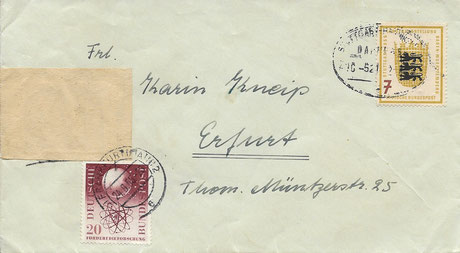- Definition
- 1870 - 1929
- 1930 - 1947
- 1948 - 1960
- Berliner Postkrieg / Berlin Postal War
- Saarland / Saarland
- Notopfer- und Wohnungsbaumarken / Emergency tax and housing tax stamps
- Bizone / Dual Zone
- DDR-Losungsstempel / GDR propaganda postmarks
- DDR-Bildganzsachen / GDR illustrated stationeries
- Helft Berlin / Help Berlin
- Atomwaffen-Ächtung / Atom bomb ostracism
- Kriegsgefangenengedenkmarke / POW remembrance stamp
- Berliner Marken / Berlin stamps
- Vertreibung / Displacement (10)
- BRD-Stempel / FRG postmarks
- Luftbrückengedenkmarke / Air Bridge Remembrance stamp
- Weltflüchtlingsjahr / World Refugees Year
- 1961 - 1970
- 1971 - 1989
- Im Umfeld / Postal war related
- Fälschungen / Forgeries
- Kein Postkrieg / No Postal War
- Abgerissene Marken / Torn off stamps
- Briefmarkentausch / Stamp exchange
- Dresdner Postkrieg / Dresden Postal War
- Fehlendes Porto / Missing postage
- Grenzfälle / Borderline cases
- Kein Postverkehr / No postal relation
- Landes- und Ortsnamen / Country and city names
- Nachgebühr / Surcharge
- Neuaufgabe / Posted again
- Poststreik / Postal strike
- Posttarife / Mail rates
- Propaganda / Werbung / Ads
- Schwärzung / Blackened
- Unautorisiert
- Unbekannt
- Ungültig / Invalid
- Unzulässig / Non admis
- Postkrieg ? / Postal War ?
- Versehen / In error
- Neu / New
- Kontakt / Contact
10 Jahre Vertreibung / 10 years displacement

Brief von Ort an der Bahnstrecke Stuttgart/Frankfurt (BRD) nach Erfurt (DDR) vom 24.8.1955. Der Bahnpoststempel auf einer 7 Pf-Marke (Tarif für Drucksache) abgestempelt. Dazu Marke “10 Jahre Vertreibung” überklebt und zusätzliche 20 Pf-Marke. Die überklebte Marke und die 20 Pf-Marke mit Tagesstempel Frankfurt(Main) 2.
Letter from a location on the Stuttgart / Frankfurt (FRG) railway to Erfurt (GDR) dated August 24, 1955. The railway postmark is applied on a 7 Pf stamp (tariff for printed matter). In addition, the stamp “10 years of displacement” pasted over and an additional 20 pfennig stamp applied. The pasted over stamp and the 20 Pf stamp canceled with day stamp Frankfurt (Main) 2.
Es gibt 2 Erklärungsmöglichkeiten:
- Der Absender hat alle 3 Marken aufgeklebt und dann die “10 Jahre Vertreibung”-Marke überklebt um einen Postkriegsbeleg zu “erzeugen”. Mit 27 Pf Porto war dem einfachen Inlandsporto von 20 Pf genüge getan. Frage bleibt hier, warum nicht beide Marken mit dem Bahnpoststempel entwertet wurden, sondern nur eine der beiden (7 Pf, was auch als Porto nicht ausreichte). Und eine Angabe es handele sich um eine Drucksache gibt es auch nicht.
- Der Brief sollte ursprünglich eine Drucksache sein, wurde dann aber anderweitig verwendet. Der Absender hat die 7 Pf-Marke verklebt und später dazu die “10 Jahre Vertreibung”-Marke. Auch die “10 Jahre Vertreibung”-Marke wurde mit dem Bahnpoststempel entwertet. In Frankfurt wurde dann die “10 Jahre-Vertreibung”-Marke samt Bahnpoststempel überklebt und auf Kosten der Post eine “unverfängliche” 20 Pf-Marke verklebt und tagesgestempelt. Frage bleibt hier, daß bisher kein anderer ähnlich behandelter Beleg bekannt ist und es auch fraglich ist, warum die Post auf eigene Kosten eine zusätzliche 20 Pf-Marke aufgeklebt haben soll. Ebenso ist fraglich warum die Post den Brief mit “10 Jahre Vertreibung”-Marke nicht einfach weitergeleitet hat, wie es auch mit dieser Marke der Fall war, oder den Brief wegen der Marke retourniert hat, was es auch gegeben hat.
- The sender stuck on all 3 stamps and then pasted the “10 years expulsion” stamp over to “generate” a postl war cover. With 27 Pfennige postage covering the simple domestic postage of 20 Pfennige was enough. The question remains, why not both stamps were canceled with the railway postmark, but only one of the two (7 Pf, which was also not sufficient as postage). And there is no indication that it is a printed matter.
- The letter was originally intended to be printed matter, but was then used only later. The sender affixed the 7 Pf stamp and later the “10 years displacement” stamp. The “10 years displacement” stamp was also canceled with the rail postmark. In Frankfurt, the “10 years displacement” stamp including the railway postmark was pasted over and a “harmless” 20 Pf stamp was affixed at the expense of the post office and day canceled. The question remains why no other similarly treated cover is known thus far and it is also questionable why the post office should have affixed an additional 20 Pf stamp at its own expense. It is also questionable why the Post did not simply forward the letter with the “10 years dislocation” stamp, as was the case with this stamp mostly, or why it returned the letter because of the stamp, which also happened.
